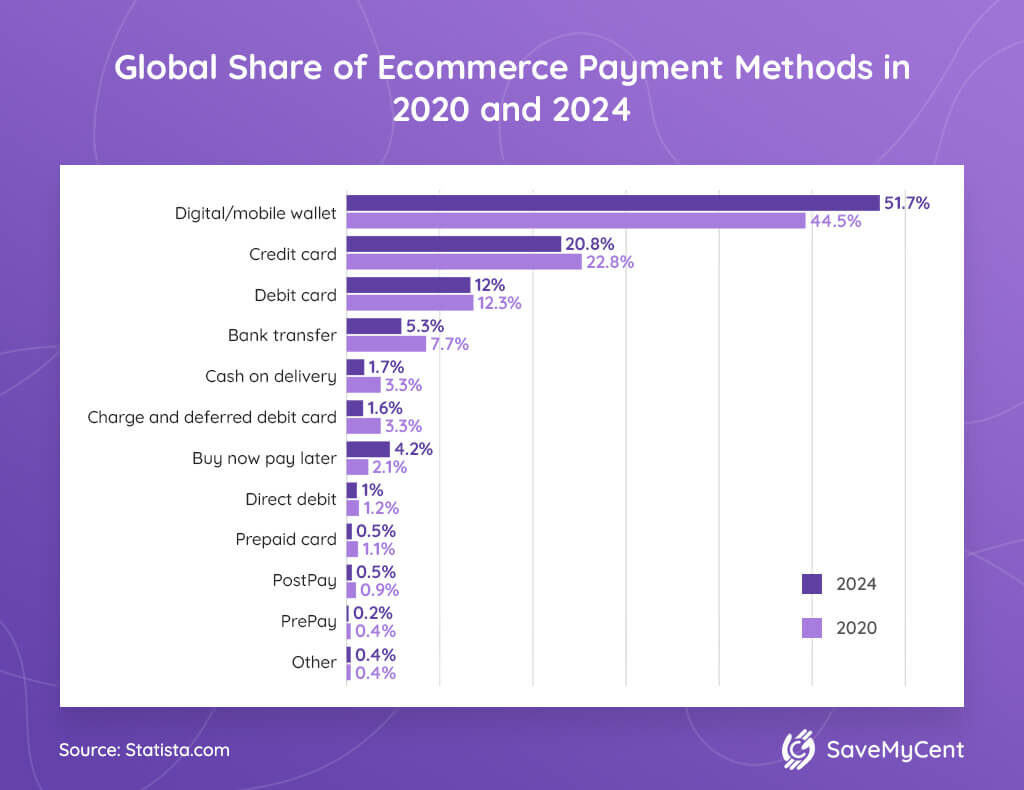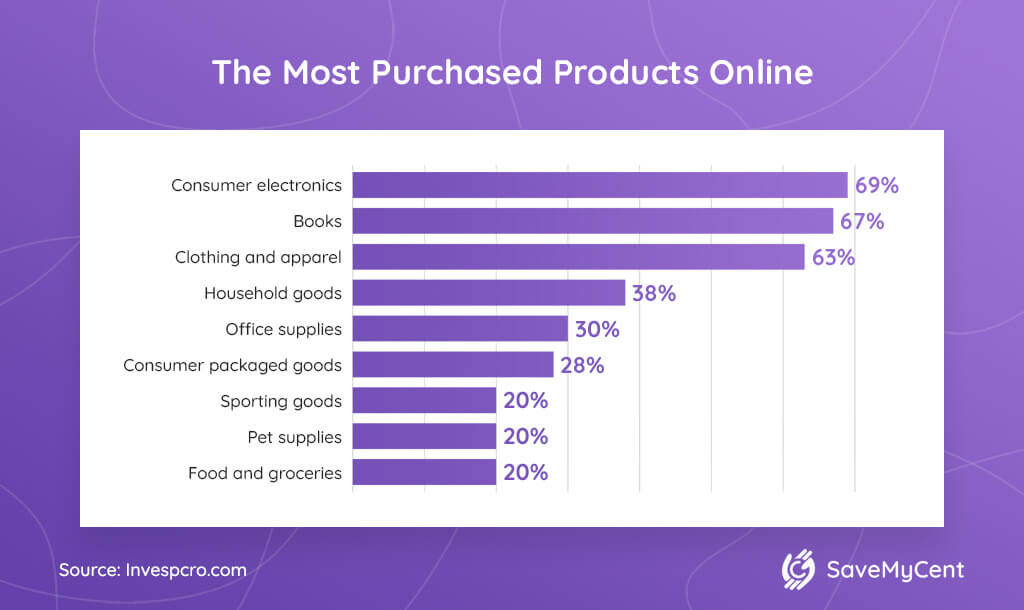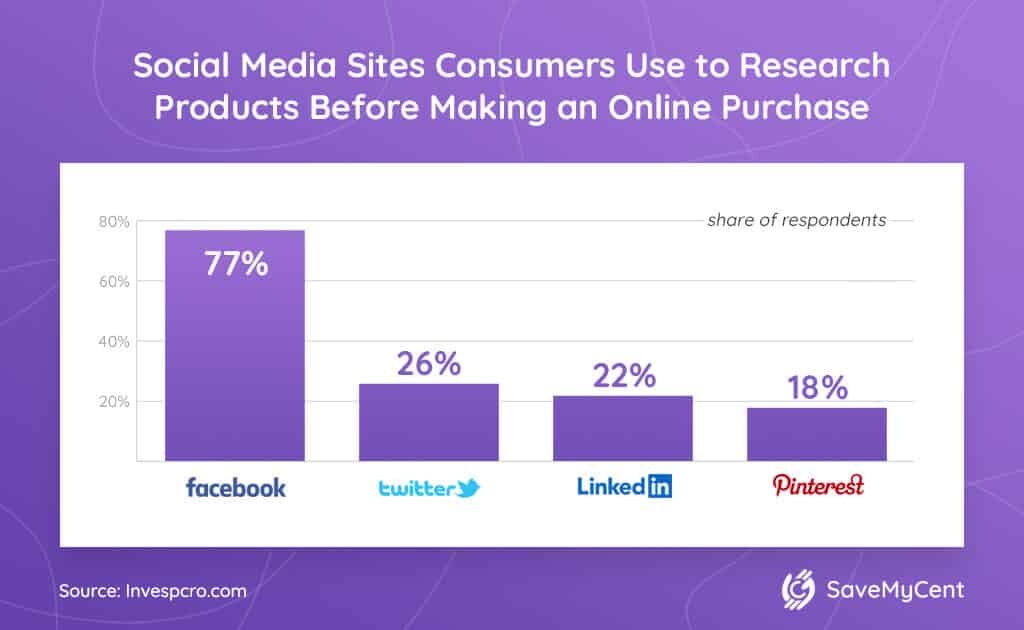Online consumer shopping habits and behavior statistics can tell us stories.
From what consumers buy to their approach when choosing between in-store and online purchases, these statistics show more prominent trends that are hard to ignore when you’re active in the ecommerce industry.
With the 2020 pandemic, ecommerce and online shopping have only become more prevalent.
What do the numbers say?
In this article, we will list the most telling and insightful consumer shopping statistics. We will cover some general facts about online shopping, online consumer habits statistics, and a few items about online buyers’ demographics.
Let’s dive right in!
Top Online Consumer Shopping Habits and Behavior Statistics (Editor’s Choice)
- Cyber Monday 2020 broke the record for the biggest online shopping event in history.
- 61% of online shoppers say navigation and ease of finding products are the most important factors of the online shopping experience, according to ecommerce trends.
- 80.64% of mobile users used the Amazon app, making it the most popular shopping app in the world.
- 58% of online consumers shop online because of its 24-hour availability.
- Men spend 68% more money on online purchases compared to women.
- Digital wallets were the preferred form of payment for online shopping in 2020.
- By 2022, voice shopping spending will grow to more than $40 billion.
Quick Online Shopping Facts and Statistics to Get You Started
1. In 2021, 2.14 billion people around the world are expected to buy goods online.
(Statista)
In 2020, an estimated 2 billion people globally purchased goods via online shops and marketplaces.
At the same time, global e-retail sales reached $4.2 trillion. Projections for 2021 show a growth up to $4.9 trillion.
The growth can be attributed to the increasing rate of mobile shopping among customers, with people using their mobile devices for various online shopping activities more often.
2. Global ecommerce sales will exceed $4.9 trillion in 2021.
(Statista)
Online shopping statistics show that global ecommerce sales reached at least $4.2 trillion last year. By 2022, that number will reach a mind-blowing $6.5 trillion.
This stat is another piece of evidence that online shopping will remain popular among customers in the future.
In the US, about 80% of internet users were expected to make at least one purchase online during 2019. That number is a 73% increase from 2013 estimates.
3. 80.64% of mobile users used the Amazon app.
(Statista)
The growth of online shopping is also largely attributed to how users can buy products online with ease. Among the most popular shopping apps in the US, Amazon ranks number one, with 80.64% of mobile users using the app.
Walmart places second with 46.08% usage among consumers, and eBay lands the third spot at 33.28%.
Other popular shopping apps include Ibotta, Target, Groupon, and Etsy.
4. The world’s largest online retailer’s net revenue was $386.1 billion in 2020.
(Statista, Amazon)
Amazon, the world’s largest online retailer, raked in $386.1 billion in 2020. A considerable increase since their 2019’s $280.5 billion net revenue.
In the first quarter of 2020, the company brought in $75.5 billion in sales revenue. This figure zooms past analysts’ estimates of $73.61 billion. The net income was $2.5 billion.
In a published company statement, Amazon’s CEO Jeff Bezos said the current crisis is “demonstrating the adaptability and durability of Amazon’s business as never before.”
5. On Cyber Monday 2020, online shoppers spent around $10.8 billion online.
(Adobe)
Online spending statistics show that the 2020’s Cyber Monday event was the biggest online shopping event in history. Online shoppers spent a staggering $10.8 billion online.
This figure exceeded last year’s Black Friday sales of $9 billion. It was also higher than the 2019’s Cyber Monday event, where consumers spent $9.4 billion on online purchases.
Smartphones were also the primary shopping tool, accounting for 41.1% of online sales. That’s 7.4% higher than the previous year’s numbers.
Useful Online Consumer Shopping Habits and Behavior Statistics
6. Around 63% of shopping starts online.
(Think with Google)
According to a study of consumer shopping habits, 63% of shopping occasions start online. In most cases, the customer journey begins with a Google or Amazon search.
That means that when customers want to buy products or services, they often start their buying journey online. Thanks to digital technology improvements, customers now seek information through online searches instead of browsing through shops for the product they want.
This consumer behavior appears to be true regardless of where they make the actual purchase, whether that’s in-store or online.
7. In 2020, digital wallets were the preferred form of payment for online shopping.

With the popularity of online shopping, many online shops and marketplaces offer a wider range of payment options. According to a study of the global consumers’ buying habits, online shoppers prefer to use eWallets in 2020 (44.5%), while credit and debit cards are the second and third most popular methods with 22.8% and 12.3%.
Predictions show that more than half of online customers will use digital wallets for ecommerce payments in 2024. This is a significant change compared to the previous years, when cards were the preferred method.
8. One-fifth of consumers worldwide would not complete an online purchase if their preferred payment method is not available.
(Research and Markets)
Nearly 20% of consumers would not complete an online purchase if they cannot use their preferred online payment method. This online shopping behavior may be due to security concerns, which is a critical factor in the consumers’ choice of payment methods amid the COVID-19 pandemic.
For example, one in five online shoppers in Italy paid using a prepaid card for the first time. Over in Canada, one-tenth of Canada’s online shoppers began using eWallets. Security and protection against fraud were top considerations for consumers when choosing online payment methods.
9. Shoppers look at more sites when buying in the Electronics (43%), Home (37%), and Furniture (37%) categories.
(Criteo)
Online purchasing stats reveal that 43% of consumers search on more than one website when looking to buy from the Electronics category. Around 37% of consumers visit multiple websites when purchasing in the Home and Furniture categories.
On the flipside, Health & Beauty (22%) and Apparel & Accessories (25%) categories tend to attract customers with brand intent. Therefore, there’s less shopping around and more site-loyal users.
10. The most purchased products online are consumer electronics (69%), books (67%), clothing and apparel (63%).

According to the latest available data on online consumer shopping habits, two-thirds of online shoppers buy electronics, books, and apparel.
On the other hand, 20% of respondents said they purchase sporting goods, pet supplies, and food and groceries online.
11. 44% of Americans have made unplanned purchases.
(CreditCards.com)
Nearly half (44%) of all Americans have made unplanned or spontaneous purchases online, according to a 2018 poll by CreditCards.com. That rate increases among older millennials and Gen Xers, who are more likely to fall for unplanned purchases than other age groups.
According to consumer psychologist Kit Yarrow, shoppers are more likely to impulse buy online than in physical shops.
The reason for this is that once shoppers are committed to buying a product online, they know they’ll have to go through the required check-out steps, which makes them more open to tossing extra items into their cart.
12. The most recent data shows that the average documented online shopping cart abandonment rate is 77.73% (2019).
(Barilliance)
The abandonment rate for online shopping carts is 77.13%, based on ecommerce customer habits surveys. Many customers who abandon their cards do “digital window shopping,” price comparisons across shops, or exploring options.
According to online purchasing stats, half of the abandoned online shopping cart cases were due to high fees for shipping, taxes, etc. Around 28% of abandonments were due to the site wanting users to create an account. Meanwhile, 21% blamed the lengthy and complicated checkout process.
In March 2020, the average online shopping cart abandonment rate was 88.05%, and the results for the whole year, with its ups and downs, are yet to be seen.
13. 58% of online consumers shop online because of its 24-hour availability.
(KPMG)
Around 58% of shoppers shop online because of its 24-hour availability. Consumers love the fact that the internet never closes, which allows them to buy whatever they want at any hour. This feature adds another layer of convenience to shopping online.
The ability to compare prices is the next most important feature for consumers (54%), just ahead of online discount sales and better prices.
14. 58% of American online shoppers would add items to their carts to get free shipping.
(Comscore)
Free shipping is an important driver of US online shopping decisions. 58% of Americans say they would add more items to their purchase to be eligible for free shipping. Further consumer spending online statistics show that 83% of shoppers are willing to wait an extra two days for delivery if that means shipping is free.
Only around 44% of online shoppers said they were satisfied with the flexibility of deliveries and the rerouting of packages. Meanwhile, 68% said free shipping was necessary for them to complete their purchase.
15. 62% would buy again from an online retailer if free returns/exchanges are available.
(MH&L)
62% of online shoppers would buy again from a brand if it offers free returns/exchanges, according to consumer shopping behavior trends. Other free stuff, such as giveaways, also entices more consumers.
Same-day shipping is on the rise, too. Consumers show more interest in free shipping and on-time delivery, as 77% of consumers say a late order arrival would impact future decisions with an online shop.
16. 50% of shoppers say they turn to a competitor after a bad customer experience.
(Bazaarvoice)
Online shoppers statistics also show that 50% of shoppers turn to a competitor after a bad customer experience. Meanwhile, 41% of customers say “poor personalization” led them to stop shopping with a company.
Bazaarvoice’s survey also showed that 71% of shoppers say “a good online customer experience is important.” Around 50% say it’s useful when retailers show them the products they are looking for. However, these numbers quickly change for the worse when shops send too many emails or make bad recommendations.
Who’s Who? The Demographics of Online Shoppers
17. Men spend 68% more money on online purchases compared to women.
(Transaction)
Online spending statistics show that, on average, men spend 68% more than women do on online shopping. The reason for this is that men spend more per transaction, rather than shop more frequently. Statistics also reveal that male consumers are likely to buy more expensive items, while women tend to buy cheaper products.
Men spend around $220 per online transaction, while women spend an average of $151 per transaction. Simultaneously, men tend to buy in bulk online to be more efficient and save time.
18. Ecommerce in Germany was worth €83.3 billion in 2020.
(Ecommerce News Europe)
Ecommerce in Germany was worth around €83.3 billion by the end of 2020. This meant that German ecommerce grew 14.6% from 2019, when the industry was estimated at around €72.6 billion.
However, the same report showed that 1 in 3 German online shoppers were older than 60, showing that due to the circumstances, older Germans joined the ecommerce market faster than it was predicted.
19.The latest data from a 2018 study shows that almost all (98%) of UK students shop online.
(Statista)
In 2018, a survey of 3,000 students and their online shopping habits showed that 98% shop online. College students’ online shopping statistics also show that 80% of them make digital purchases at least once a month.
Around 50% of 18-to-22-year-old students tend to shop online once a week. Meanwhile, 46% of male students shop online once a week, while 44% of their female counterparts do the same. Males shop online for tech and mobile purchases more often than females.
20. The vast majority (95%) of online shoppers are between 18 to 74 years old.
(DISQO)
According to DISQO, around 95% of online shoppers are between 18 and 74 years old. Millennials account for only 30% of online shoppers, while Gen Z shoppers account for 34%. Boomers make up 31% of the count.
The ecommerce platforms where they often shop include Amazon, Target, and Macy’s. It’s important to note that the survey defines “online shopping” as any engagement with a platform included in their ecommerce category.
21. 57% of Generation Z shoppers prefer to buy in-store.
(PR Newswire)
Despite being digital natives, 57% of Gen Z buyers say they prefer to buy in-store rather than online. Online shopping demographics reports also show that 63% of Gen Z buyers are active in at least one loyalty program.
If an online shop has a loyalty program, it also attracts 64% more buyers from Gen Z buyers and millennials.
Furthermore, Gen Z buyers want more personalized experiences and engagement across all channels. This includes both in-store and online shopping.
22. 64% of Americans still prefer brick-and-mortar stores.
(Pew Research Center)
Despite the growing popularity of online shopping, 64% of Americans said they would still prefer buying in-store.
Most people still consider the price when deciding whether to buy in-store or online, however. A neat 65% of Americans say they typically compare the price they can get online versus in-store and go with whichever is the cheapest.
Around one in five buyers (21%) say they would buy in-store without checking online prices first. Around 14% would buy online without checking prices in-store first.
Tech-Related Ecommerce Customer Habits
23. 77% of shoppers refer to Facebook before making an online purchase.

Around 77% of shoppers go to Facebook first for recommendations and referrals before making an online purchase. Twitter comes next, with 26% of shoppers visiting the platform to study a product before purchasing. Meanwhile, around 22% of shoppers look for recommendations on LinkedIn. Approximately 18% of shoppers would search on Pinterest.
A huge 84% of online shoppers say they refer to at least one social media site for recommendations before buying online.
24. 79% of Americans have made online purchases, 51% via cellphone.
(Pew Research Center)
Ecommerce trends show that around 79% of Americans have made online purchases. 51% of those made the purchase via their mobile phones, and 15% of those made purchases via links found on social media sites.
Nearly 45% of American shoppers have also used phones while inside a store to look up online reviews of the products they wanted to buy.
25. By 2021, mobile ecommerce will account for 54% of total sales.
(BigCommerce)
Online shopping trends suggest that mobile ecommerce, or mcommerce, will account for 54% of all ecommerce sales. For comparison, in 2017, mobile ecommerce accounted for 34% of all sales.
The data suggests not only that mobile ecommerce will continue to grow, but it will also affect consumers’ buying decisions. That’s because consumers are increasingly using mobile devices to look up additional information on a product.
26. 64% of shoppers prefer 24-hour service chatbots.
(Convince&Convert)
Chatbots are popular among online shoppers. 64% of them cited “24-hour service” as the primary benefit of chatbots. The second most-mentioned benefit is “getting an instant response,” which was cited by 55% of survey participants.
Online shopping trends statistics also show that “getting answers to simple questions” (55%) and “easy communication” (51%) were among the top benefits of chatbots for online shoppers. Meanwhile, “friendliness and approachability” ranks low (32%).
27. 43% of shoppers say they’d still prefer to deal with a real person.
(Convince&Convert)
Even though chatbots are highly popular, 43% of US shoppers still say they’d rather deal with a human. These shoppers say they prefer real-life assistants because of their “innate desire to interact with others,” which is also the top reason shoppers would stop using chatbots.
In a related statistic, 30% of shoppers worry that the chatbot would make a mistake.
28. 51% of shoppers say a personalized online shop homepage is important.
(Bazaarvoice)
More than half of online shoppers (51%) say personalized homepages are of high value to them across all categories. However, only 25% say they have experienced such personalized shops, while only 20% say they see relevant product recommendations.
In a related statistic, only 24% of online retailers deliver a real-time personalized experience across their channels, even though most retailers in the industry claim to prioritize customer personalization.
29. 71% of shoppers say “a good online customer experience” is essential to them.
(Bazaarvoice)
Online purchasing stats show that good online customer experience is a major turn-on for online buyers. Around 71% of shoppers count it as one of the most critical factors for online shopping. This survey shows that the only thing that’s more important than customer experience is price competition: 73% of shoppers say high prices push them to find another store.
Good recommendations are part of the “good online customer experience”, as 38% of shoppers say they won’t return to an online shop that recommends items that are not relevant.
30. 35% of shoppers say they would shop online more often if they could virtually try stuff before buying.
(ThinkMobiles)
More online consumer behavior statistics show that 35% of online shoppers would be more willing to shop online if they could try products virtually. Also, 22% would be less likely to go to brick-and-mortar shops if AR is available in online shops.
Research also experimented with the psychological impacts of AR marketing in ecommerce: 45% of buyers who saw visual aids wanted to buy a product. In comparison to 74% of those who used AR wished to purchase the item.
31. 34% of shoppers use Augmented Reality (AR) when shopping, and 47% use it both online and in-store.
(Connected Consumer)
Customers simply prefer shops that offer augmented reality.
According to online shoppers statistics, more than a third (34%) of shoppers use AR when they go shopping. 47% of those use it in both online and in-store shopping.
Meanwhile, 77% of those who have used AR use it to see product differences, such as colors and styles. Nearly 65% want to get product information, and 41% say they use it to find special deals and promotions.
32. By 2022, voice shopping spending will grow to more than $40 billion.
(DialogTech)
Voice shopping accounts for $2 billion in consumer spending. However, it may grow to $40 billion by 2022. Around 43% of voice-enabled owners use their devices to shop. About 22% of those buy products directly through voice, while 17% have used it to reorder items.
Other users use voice search to perform a task: 58% of consumers use voice search to find local business information, while 51% use it to research restaurants.
The Power of Consumer Behavior: Final Thoughts
These stats show us that the broader ecommerce industry is quickly evolving, driven by changing consumer behavior and habits. With the changes in online consumer shopping habits and behavior statistics, we’ll also see shifts in the way ecommerce businesses try to attract buyers.
Also, demographics and technological advancements will contribute to the rapid evolution of online shopping. With better tech, customers are able to shop online whenever and wherever they want.
Overall, it’s safe to expect more changes and faster development in the way consumers buy online — even in the face of a worldwide challenge like a pandemic.
Frequently Asked Questions
What is online consumer behavior?
Online consumer behavior is the customers’ decision-making process when buying something online and the factors that affect their decision. Those factors may be internal (attitude, knowledge of the product, etc.) or external (demographic, generation, etc.).
Understanding these behaviors and factors dictates online buying trends, which helps the broader ecommerce industry make their products more competitive.
What are consumer buying habits?
Consumer buying habits are the trends and repeated behaviors that buyers have when they shop. These are tendencies that come from various factors. For example, a customer’s buying habit of comparing prices online and in-store may result from their eagerness to save money.
Among the other things that influence consumer buying habits are demographics, location, method, and platform.
Why do consumers buy online?
Online shopping trends show many of the obvious reasons people buy things online. For example, 65% of American shoppers compare prices online and in-store. This is because they can easily compare prices, often with a touch of a button. Prices in online shops are usually lower than in-store prices.
Another reason consumers buy online is convenience. This way, they don’t only save money, but they also save time.
Of course, in 2020, we found another reason to shop online: safety.
Which of the products are people most likely to buy online?
Online shopping growth statistics show different categories of products that are in demand. For instance, peel-off masks were incredibly popular in 2020. However, people often look across different websites when buying within the Electronics, Home, and Furniture categories. Specific examples may be cellphones, laptops, gamepads, chairs, placemats, kitchen items, etc.
Many online shoppers also often buy fashion items, tech products, second-hand items, books, and even educational courses.
Percent of consumers who research online before buying?
Around 88% of consumers research online before purchasing either online or in-store. Shoppers search for descriptions, reviews, and testimonials on the product they want to buy. Trends in online shopping also indicate that buyers want flexible payment options before purchasing the product or service.
Customer research is also becoming easier as mobile ecommerce evolves. Better technologies like AI for chatbots and augmented reality are also making it easier for customers to research products.
How has ecommerce changed the way consumers purchase?
Online purchasing trends show that ecommerce indeed changed the way consumers buy products. Previously, shoppers needed to go to brick-and-mortar stores to shop. They have to travel physically and see the products personally before making the purchase.
Ecommerce has changed this by bringing the shopping experience to the consumers’ fingertips. Computers and mobile devices have transformed into shopping centers.
When looking at the statistics and trends, we can expect ecommerce to continue changing the shopping landscape.
What do people buy the most online?
Items that people buy the most online include:
- Peel-off face masks
- Water bottles
- Blankets
- Yoga and pilates mats
- Exercise bands
- Kitchen and dining room furniture
- Board games
- Nail polish
- Laptop skins
Of course, online consumer shopping habits and behavior statistics change, and the same goes for these products. Customers might not be buying these things online as often in the coming years.
Sources:
- Amazon
- Amazon
- Bazaarvoice
- BigCommerce
- Comscore
- Connected Consumer
- Convince&Convert
- CreditCards.com
- Criteo
- DialogTech
- Ecommerce News Europe
- Statista
- Invesp
- KPMG
- MH&L
- Pew Research Center
- PR Newswire
- Research and Markets
- Statista
- Statista
- Statista
- Statista
- ThinkMobiles
- Think with Google
- Transaction
- DISQO
- Octane AI
- Statista
- Adobe
- Barilliance


![32 Impressive Online Consumer Shopping Habits and Behavior Statistics [For 2024]](https://savemycent.com/wp-content/uploads/thumbs_dir/14-Online-Reviews-Statistics-1-qbt0ze39vgzudubn8m6yzccj0auonhcbx615pg6at8.jpg)
![32 Impressive Online Consumer Shopping Habits and Behavior Statistics [For 2024]](https://savemycent.com/wp-content/uploads/thumbs_dir/Selling-Used-Clothes-on-eBay-qbt199e9mui8afzjlvry5uorjy7fh2iva0mp41jhh8.png)



![How to Get Free Clothes From Shein? [2024 Guide]](https://savemycent.com/wp-content/uploads/2023/09/How-to-Get-Free-Clothes-From-Shein-336x220.png)
